
A Nightmare on Elm Street is an American supernatural slasher media franchise consisting of nine films, a television series, novels, comic books, and various other media. The franchise began with the film A Nightmare on Elm Street (1984), written and directed by Wes Craven. The overall plot of the franchise centers around the fictional character Fred "Freddy" Krueger, the apparition of a former child killer who was burned alive by the vengeful parents of his victims, who returns from the grave to terrorize and kill the teenage residents of the fictional Springwood, Ohio in their dreams. Craven returned to the franchise to co-script the second sequel, A Nightmare on Elm Street 3: Dream Warriors (1987), and to write/direct Wes Craven's New Nightmare (1994). The films collectively grossed $472 million at the box office worldwide.

Freddy Krueger is a fictional character and the primary antagonist in the A Nightmare on Elm Street film series. He was created by Wes Craven and made his debut in Craven's A Nightmare on Elm Street (1984) as the malevolent spirit of a child killer who had been burned to death by his victims' parents after evading prison. Krueger goes on to murder his victims in their dreams, causing their deaths in the real world as well. In the dream world, he is a powerful force and seemingly invulnerable. However, whenever Freddy is pulled back into the real world, he has normal human vulnerabilities and can be destroyed. He is commonly identified by his burned, disfigured face, dirty red-and-green-striped sweater and brown fedora, and trademark metal-clawed, brown leather, right hand glove. This glove was the product of Krueger's own imagination, having welded the blades himself before using it to murder many of his victims, both in the real and dream worlds. Over the course of the film series, Freddy has battled several reoccurring survivors including Nancy Thompson and Alice Johnson. The character was consistently portrayed by Robert Englund in the original film series as well as in the television spin-off Freddy's Nightmares.
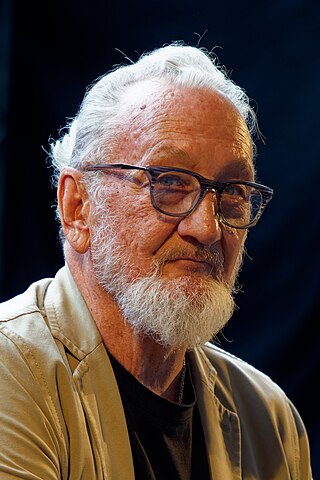
Robert Barton Englund is an American actor and director, best known for playing the supernatural serial killer Freddy Krueger in the Nightmare on Elm Street film series. Classically trained at the Royal Academy of Dramatic Art, Englund began his career as a stage actor in regional theatre, and made his film debut in Buster and Billie in 1974. After supporting roles in films in the 1970s such as Stay Hungry, A Star Is Born, and Big Wednesday, Englund had his breakthrough as the resistance fighter Willie in the miniseries V in 1983. Following his performance in the original A Nightmare on Elm Street in 1984, he became closely associated with the horror film genre, and is widely-regarded as one of its iconic actors.

Stephen Ross Gerber was an American comic book writer and creator of the satiric Marvel Comics character Howard the Duck. Other works include Man-Thing, Omega the Unknown,Marvel Spotlight: "Son of Satan", The Defenders,Marvel Presents: "Guardians of the Galaxy", Daredevil and Foolkiller. Gerber often included lengthy text pages in the midst of comic book stories, such as in his graphic novel, Stewart the Rat. Gerber was posthumously inducted into the Will Eisner Comic Book Hall of Fame in 2010.

Freddy's Nightmares is an American horror anthology television series, which aired in syndication from October 1988 until March 1990. A spin-off from the A Nightmare on Elm Street film series, each episode is introduced by Freddy Krueger, and features two different stories, with eight of them throughout the series actually having Freddy Krueger as the main antagonist. The pilot episode was directed by Tobe Hooper, and begins with Krueger's prosecution on child-murdering charges.

Freddy's Dead: The Final Nightmare is a 1991 American slasher film and the sixth film in the A Nightmare on Elm Street franchise. It is a sequel to A Nightmare on Elm Street 5: The Dream Child and was originally intended to be the final installment of the series; Wes Craven's New Nightmare was released three years later but takes place outside the series canon. A canonical crossover/sequel, Freddy vs. Jason, was released in 2003. This was New Line Cinema's first 3D film release.
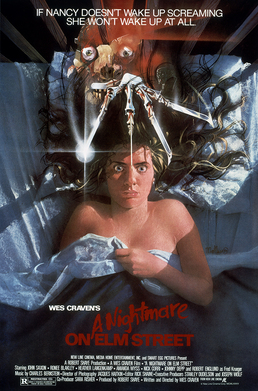
A Nightmare on Elm Street is a 1984 American supernatural slasher film written and directed by Wes Craven and produced by Robert Shaye. It is the first installment in the A Nightmare on Elm Street franchise and stars Heather Langenkamp, John Saxon, Ronee Blakley, Robert Englund as Freddy Krueger, and Johnny Depp in his film debut. The film's plot concerns a group of teenagers who are targeted by Krueger, an undead former child killer who can murder people through their dreams, as retribution against their parents who burned him alive.

A Nightmare on Elm Street 3: Dream Warriors is a 1987 American fantasy slasher film directed by Chuck Russell in his feature directorial debut. The story was developed by Wes Craven and Bruce Wagner and is the third installment in the Nightmare on Elm Street franchise and stars Heather Langenkamp, Patricia Arquette, Larry Fishburne, Priscilla Pointer, Craig Wasson, and Robert Englund as Freddy Krueger. The film follows Nancy Thompson, now a psychiatrist, and Kristen, a patient who can bring others into her own dreams, team up with other kids to launch a daring rescue into the dreamland and save a child from Freddy Krueger.

A Nightmare on Elm Street 4: The Dream Master is a 1988 American fantasy slasher film and the fourth installment in the A Nightmare on Elm Street franchise. The film was directed by Renny Harlin and stars Robert Englund, Lisa Wilcox, and Danny Hassel. Following the death of Nancy Thompson, Krueger reappears in the dreams of Kristen Parker, Joey Crusel, and Roland Kincaid. After completing his revenge against the families who killed him, Krueger uses Kristen's best friend, Alice Johnson, to gain access to new victims in order to satiate his murderous needs. The film is a sequel to A Nightmare on Elm Street 3: Dream Warriors (1987). The Dream Master is often popularly referred to as "the MTV Nightmare" of the franchise.
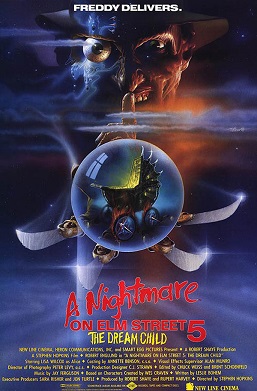
A Nightmare on Elm Street 5: The Dream Child is a 1989 American gothic slasher film directed by Stephen Hopkins and written by Leslie Bohem. It is the fifth installment in the A Nightmare on Elm Street franchise, and stars Lisa Wilcox, and Robert Englund as Freddy Krueger. The film follows Krueger, using a now pregnant Alice Johnson's baby's dreams to claim new victims.
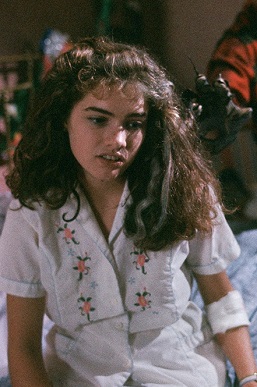
Nancy Thompson is a fictional character in the A Nightmare on Elm Street franchise. She first appears in A Nightmare on Elm Street (1984) as a teenager hunted in her dreams by enigmatic serial killer Freddy Krueger. In this film, she was portrayed by Heather Langenkamp—who reprises the role in the sequel, A Nightmare on Elm Street 3: Dream Warriors (1987). Langenkamp later portrayed a fictional version of herself who embodies the role of Nancy in Wes Craven's New Nightmare (1994). A reimagined version of the character, Nancy Holbrook, is portrayed by Rooney Mara in the 2010 remake.

Kristen Parker is a character from the A Nightmare on Elm Street series. She is a co-protagonist and final girl of the third film of the series A Nightmare on Elm Street 3: Dream Warriors and the false protagonist in the following film A Nightmare on Elm Street 4: The Dream Master, and has appeared in various merchandise as well. She is played by actress Patricia Arquette in Dream Warriors and Tuesday Knight in The Dream Master. She is the central member of the titular Dream Warriors, seven teens who have to learn to fight as a group in order to survive their spectral tormentor, enigmatic murderer Freddy Krueger, and has the ability to bring others into her dreams as well as being an Olympic-level acrobat in her dreams.
The popularity of the A Nightmare on Elm Street film series has led to several comic book series published by Marvel Comics, Innovation Publishing, Trident Comics, Avatar Press and WildStorm Productions. After the success of Freddy vs. Jason and The Texas Chainsaw Massacre remake film in 2003, New Line Cinema created their House of Horror licensing division which licensed the A Nightmare on Elm Street franchise to Avatar Press for use in new comic book stories, the first of which was published in 2005. In 2006, Avatar Press lost the license to DC Comics imprint, WildStorm Productions which then published several new stories based on the franchise before their license expired as well.

Freddy vs. Jason vs. Ash: The Nightmare Warriors is a six-issue limited series comic book written by Jeff Katz and James Kuhoric, with drawings by Jason Craig. The series was published by Dynamite Entertainment and DC Comics, with imprint by Wildstorm, beginning in August 2009 and concluding in December 2009. The Nightmare Warriors is a sequel to Freddy vs. Jason vs. Ash, which was published in 2007 and was itself a sequel to the 2003 film Freddy vs. Jason. The series is a crossover between the A Nightmare on Elm Street, Friday the 13th, and Evil Dead horror film franchises.
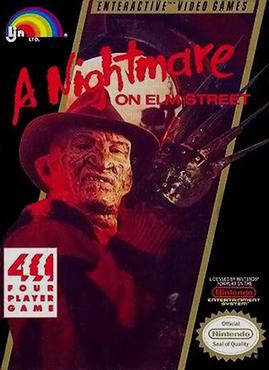
A Nightmare on Elm Street is a video game released on the Nintendo Entertainment System in 1990 based on Wes Craven's slasher film of the same name. The game was developed by Rare and published by LJN. It should not be confused with an unrelated game with the same title for the Commodore 64 and IBM PC released in 1989.
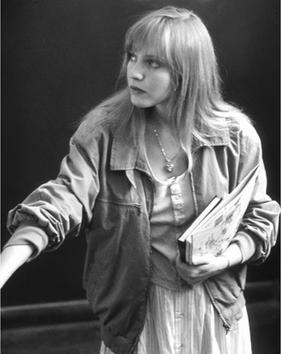
Alice Johnson is a fictional character in the A Nightmare on Elm Street franchise. She first appears in A Nightmare on Elm Street 4: The Dream Master (1988) as a teenager that inherits dream superpowers from the victims of enigmatic serial killer Freddy Krueger. In this film, she was portrayed by Lisa Wilcox—who reprises the role in A Nightmare on Elm Street 5: The Dream Child (1989).
1428 Elm Street, also known as [the] Elm Street House, is a fictional residential house and street address in Springwood, Ohio, and is an important location in the A Nightmare on Elm Street franchise, where it has been the home of Nancy Thompson and her mother, later Jesse Walsh and his family, and finally Lori Campbell and her father, throughout the film series. It has also been implied to have been Freddy Krueger's home at some point before the events that take place in the films. It appears in some form in nearly all the films, as well as literature, comic books, toys, and music videos. The house, like Freddy Krueger, Nancy Thompson, Tina Gray, and Kristen Parker, were all conceived by Wes Craven.
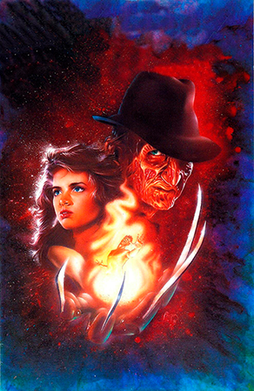
Nightmares on Elm Street is a six-issue comic book limited series set within the A Nightmare on Elm Street franchise, set chronologically between A Nightmare on Elm Street 5: The Dream Child (1989) and Freddy's Dead: The Final Nightmare (1991). It was written by comic book writer Andy Mangels and published bimonthly throughout 1991 and 1992 by Innovation Publishing. The first two issues revolves mainly around Nancy Thompson's fate following her murder by Freddy Krueger in A Nightmare on Elm Street 3: Dream Warriors, while issue three through six deals primarily with the return of Alice Johnson and her son Jacob to Springwood. The comics are considered to be canonical to the franchise.

















